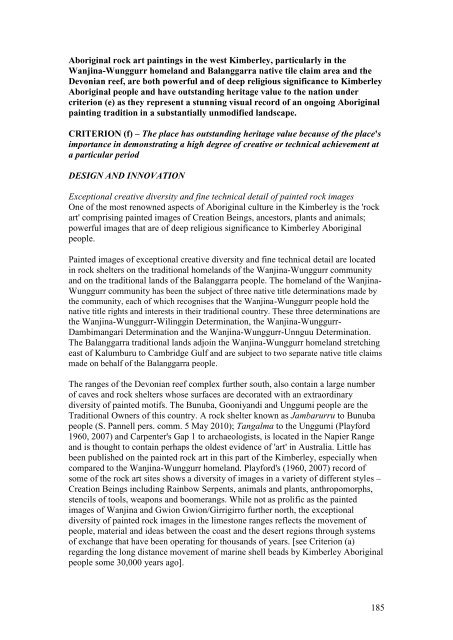WEST KIMBERLEY PLACE REPORT - Department of Sustainability ...
WEST KIMBERLEY PLACE REPORT - Department of Sustainability ...
WEST KIMBERLEY PLACE REPORT - Department of Sustainability ...
You also want an ePaper? Increase the reach of your titles
YUMPU automatically turns print PDFs into web optimized ePapers that Google loves.
Aboriginal rock art paintings in the west Kimberley, particularly in the<br />
Wanjina-Wunggurr homeland and Balanggarra native tile claim area and the<br />
Devonian reef, are both powerful and <strong>of</strong> deep religious significance to Kimberley<br />
Aboriginal people and have outstanding heritage value to the nation under<br />
criterion (e) as they represent a stunning visual record <strong>of</strong> an ongoing Aboriginal<br />
painting tradition in a substantially unmodified landscape.<br />
CRITERION (f) – The place has outstanding heritage value because <strong>of</strong> the place's<br />
importance in demonstrating a high degree <strong>of</strong> creative or technical achievement at<br />
a particular period<br />
DESIGN AND INNOVATION<br />
Exceptional creative diversity and fine technical detail <strong>of</strong> painted rock images<br />
One <strong>of</strong> the most renowned aspects <strong>of</strong> Aboriginal culture in the Kimberley is the 'rock<br />
art' comprising painted images <strong>of</strong> Creation Beings, ancestors, plants and animals;<br />
powerful images that are <strong>of</strong> deep religious significance to Kimberley Aboriginal<br />
people.<br />
Painted images <strong>of</strong> exceptional creative diversity and fine technical detail are located<br />
in rock shelters on the traditional homelands <strong>of</strong> the Wanjina-Wunggurr community<br />
and on the traditional lands <strong>of</strong> the Balanggarra people. The homeland <strong>of</strong> the Wanjina-<br />
Wunggurr community has been the subject <strong>of</strong> three native title determinations made by<br />
the community, each <strong>of</strong> which recognises that the Wanjina-Wunggurr people hold the<br />
native title rights and interests in their traditional country. These three determinations are<br />
the Wanjina-Wunggurr-Wilinggin Determination, the Wanjina-Wunggurr-<br />
Dambimangari Determination and the Wanjina-Wunggurr-Unnguu Determination.<br />
The Balanggarra traditional lands adjoin the Wanjina-Wunggurr homeland stretching<br />
east <strong>of</strong> Kalumburu to Cambridge Gulf and are subject to two separate native title claims<br />
made on behalf <strong>of</strong> the Balanggarra people.<br />
The ranges <strong>of</strong> the Devonian reef complex further south, also contain a large number<br />
<strong>of</strong> caves and rock shelters whose surfaces are decorated with an extraordinary<br />
diversity <strong>of</strong> painted motifs. The Bunuba, Gooniyandi and Unggumi people are the<br />
Traditional Owners <strong>of</strong> this country. A rock shelter known as Jambarurru to Bunuba<br />
people (S. Pannell pers. comm. 5 May 2010); Tangalma to the Unggumi (Playford<br />
1960, 2007) and Carpenter's Gap 1 to archaeologists, is located in the Napier Range<br />
and is thought to contain perhaps the oldest evidence <strong>of</strong> 'art' in Australia. Little has<br />
been published on the painted rock art in this part <strong>of</strong> the Kimberley, especially when<br />
compared to the Wanjina-Wunggurr homeland. Playford's (1960, 2007) record <strong>of</strong><br />
some <strong>of</strong> the rock art sites shows a diversity <strong>of</strong> images in a variety <strong>of</strong> different styles –<br />
Creation Beings including Rainbow Serpents, animals and plants, anthropomorphs,<br />
stencils <strong>of</strong> tools, weapons and boomerangs. While not as prolific as the painted<br />
images <strong>of</strong> Wanjina and Gwion Gwion/Girrigirro further north, the exceptional<br />
diversity <strong>of</strong> painted rock images in the limestone ranges reflects the movement <strong>of</strong><br />
people, material and ideas between the coast and the desert regions through systems<br />
<strong>of</strong> exchange that have been operating for thousands <strong>of</strong> years. [see Criterion (a)<br />
regarding the long distance movement <strong>of</strong> marine shell beads by Kimberley Aboriginal<br />
people some 30,000 years ago].<br />
185
















